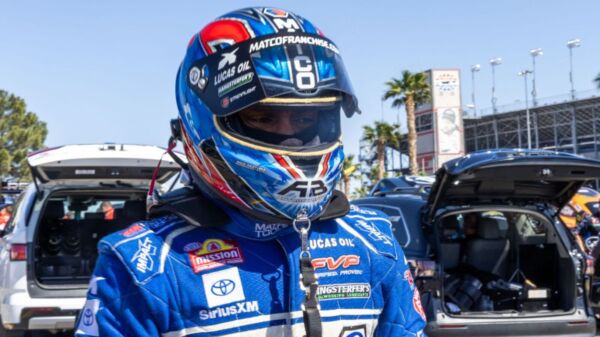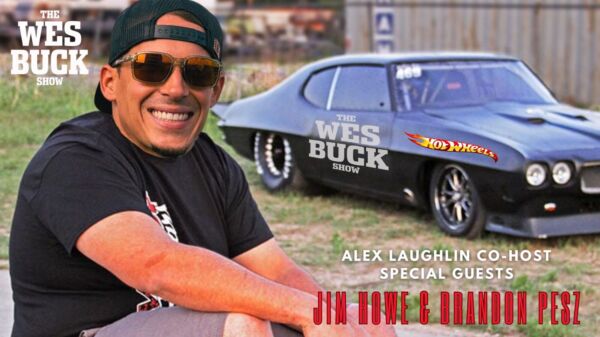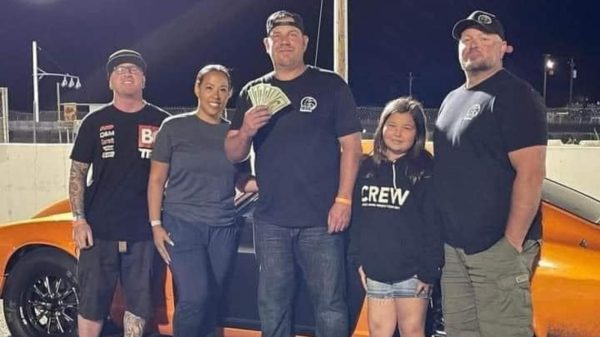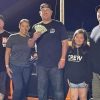A throaty, deafening roar overcomes the Darlington Dragway starting line as John Strickland and Kevin Rivenbark bring their ProCharger-boosted GALOT Motorsports ’69 Camaros to life and rip through the water box. It’s the Pro Boost final round at the PDRA Carolina Showdown presented by ProCharger, and it’s the realization of the GALOT team’s dream they had late in 2018 when looking for a combination that would put them on the leading edge of the competition while also offering a more manageable program.
In the first all-ProCharger final in PDRA Pro Boost history, Strickland scored the victory over Rivenbark, the defending world champion. Strickland used a holeshot advantage and 3.668 at 202.16 mph to finish ahead of Rivenbark and his 3.684 at 203.71. It was their first time meeting in a final round since their dominant 2016 season when Todd Tutterow oversaw their roots-blown program.
[Editor’s Note: This story originally appeared in DI #158, the State of Drag Issue, in July of 2020.]
Even with the success the duo had with the roots combination in 2016, they were looking for something different in 2019 and beyond. As it turns out, ProCharger’s brand of centrifugal superchargers was exactly what they needed.
“I enjoy the ProCharger a lot more than the roots,” Strickland says. “The roots was really strong out of the gate, then always kind of laid over and you felt like you wanted to throw your foot out the door and give it a little push out the back. This thing, from start to finish, it just feels like it pulls all the way through. It’s so exciting, especially on a pass like that [3.66]. It holds you back the whole time.”
Strickland and Rivenbark are just two drivers of the many across numerous categories who have turned to ProCharger and Vortech, ProCharger’s biggest competitor in the centrifugal blower arena, for a power adder that offers valuable qualities in classes ranging from high-level Pro Modified racing to fast bracket racing.
Racers using every other power adder – nitrous oxide injection, turbochargers, roots blowers and screw superchargers – have made the switch to centrifugal blowers, which prompts some big questions. Why? How has the centrifugal supercharger, which was first conceptualized at its most basic level in the early 20th century, started to take over drag racing? Why are so many racers making the switch? What’s next for the platform?
To get the answers to these questions and more, Drag Illustrated spoke with representatives from the two leading brands in centrifugal supercharging, as well as some of the drivers, tuners and engine builders who’ve worked with the products and experienced considerable success with them.
ProCharger Goes Pro Mod Racing
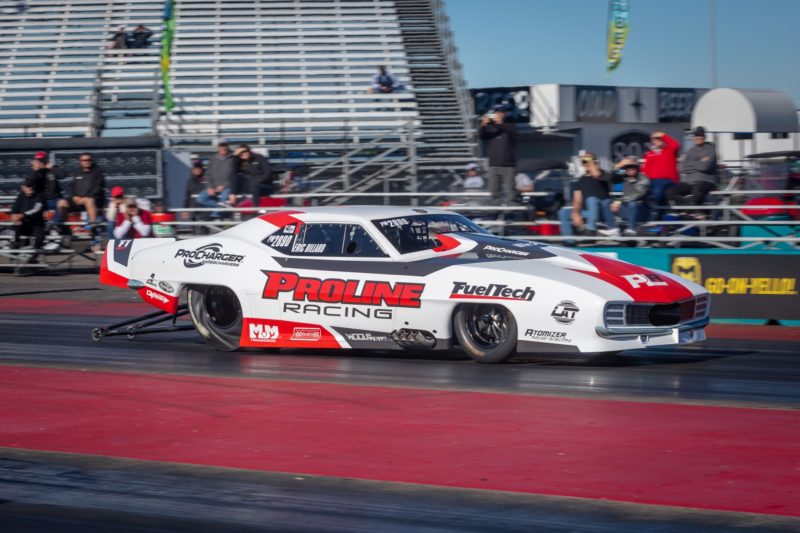
James Sisk photo
Pro Modified has been a class subject to trends since its earliest days in the early ‘90s. Body styles would come in and out, from the ’53 Corvettes and ’41 Willys at the beginning to the late-model Camaro bodies that’ve become the norm. Similarly, power adders have had their moments. Nitrous oxide paved the way before roots-style superchargers took over, with the twin-turbo setup making major moves in the late 2000s and early 2010s. Screw blowers set the pace in outlaw Pro Mod classes.
Now, centrifugal superchargers are having their moment. ProCharger is leading the way with its F-3X-140 superchargers in NMCA Xtreme Pro Mod, PDRA Pro Boost and, new for 2020, NHRA Pro Mod. It’s the company’s biggest, baddest blower.
“With Pro Mod in general, non-NHRA classes, it really started with our introduction of the F-3X-140 ProCharger,” says Walt Sipp, ProCharger’s technical service manager. “That supercharger has been able to support a higher level of power than our F-3R-136, which was for a long time our largest supercharger we made. The 136 typically would be a 3,000-horsepower-capable supercharger. The 140 pushed that power level up by about 500 horsepower, which is more in line with what guys were needing in a Pro Mod category as cars were getting quicker and faster. That was a big part of it. We were finally able to have a supercharger that was capable of running the numbers guys would expect to run.”
ProCharger had customers in NMCA and PDRA running the F-3R-136 with some success. Then, the company started to work with Pro Line Racing Engines to develop the F-3X-140. Pro Line put together a “house car” with ProCharger components, which made its competition debut at the Mid-West Pro Mod Series’ Elite 16 race at Texas Motorplex in late 2018.
“We had really good testing partners with Pro Line Racing,” Sipp says. “They really jumped on board and were looking for the new, latest and greatest thing. That really helped us develop our next level of superchargers and be able to run at an NHRA Pro Mod level.”
In just one race, the Pro Line ProCharger ’69 Camaro, driven by Pro Line co-founder Eric Dillard, made major waves in the Pro Mod world. It caught the attention of Rivenbark and the GALOT team, who bought Dillard’s car and had Pro Line convert Strickland’s roots-blown ’69 Camaro to an identical ProCharger setup.
ProCharger continued to work with Pro Line on the GALOT cars throughout the 2019 season. Rivenbark went back and forth between big tires in Pro Boost and small tires in Radial vs. the World. In RvW, he set numerous ProCharger records, and even became the first small-tire car to break into the 3.50s en route to a $101,000 victory at DuckX Productions’ Sweet 16 2.0.
The mechanical minds at Pro Line, including Dillard and tuners like Steve Petty and Brandon Stroud, worked together with ProCharger to refine the F-3X-140 and prove its potential to other racers.

Steve Petty (Chris Sears photo)
“We had really good racers and tuners and engine builders that we’ve worked with for years and we appreciate everything that they’ve all done,” Sipp says. “Pro Line just presented a whole different angle in that they do everything in-house as far as the building, dyno tuning, going to the track, taking care of customer cars and so on. Very few, if any others, could do that. They could do everything. We could provide components to them. They could actually put it on the dyno and do the testing and take it to the track with a customer’s car and see what it would do with their in-house tuners.”
What they ended up doing was win the 2019 PDRA Pro Boost world championship. Rivenbark scored the title, adding to his 2016 championship, with two wins and a runner-up finish. ProCharger customers have won plenty of championships before, but this one meant a little something more. It was a sign the company was going in the right direction with its new Pro Mod blower.
“We worked hard and we knew what we could expect,” Sipp says. “We knew what the cars were capable of running. We absolutely expected success. Now to win a championship takes a lot more than expecting success. That takes dedicated guys going out there and doing it and a little bit of luck and a quick car. Could we say we expected a championship? Absolutely not. To set records? Hopeful. Did we expect success? Yes.”
Shortly after Rivenbark claimed his championship, the ProCharger contingent scored another major victory. NHRA announced in late November that the ProCharger F-3X-140 would be allowed in NHRA Pro Mod competition. It was the result of ProCharger working with NHRA to come to a mutual understand – NHRA Pro Mod tech officials understanding the product and ProCharger engineers understanding NHRA’s expectations for a new power adder to join Pro Mod’s already contentious parity debate.
“That was proof that we have taken the next step,” Sipp says of NHRA allowing the ProCharger. “With NHRA, there are a lot of other things that are involved in that process, not just having a supercharger that can run a number. It was working with them to help them understand our product so we could have a rules package put together.
“It wasn’t only our supercharger,” Sipp adds. “We also came out with our own crank drive, so we could provide a complete solution to NHRA. You could get the drive, the blower, the bell, the valves, the whole package, which is really what they were looking for. When they change or add a power adder like this, they want to make sure it’s 100 percent ready to go and they’re not needing to verify this part or that part from different companies. They can basically come to one company and say, ‘OK, provide us the whole package that we can govern.’”
As a part of the process, ProCharger engineers and reps have had to educate the racing public about the combination and its differences. It has the same basic premise as other forced induction power adders – shoving more air into the engine – but it accomplishes that task differently than the other power adders. Boost levels, transmission and converter technology, gear ratios and more come into play, Sipp explains.
“We’ve had to educate and have some discussions with racers and with NHRA to some degree,” Sipp says. “We’ve been legal in NHRA classes for a long time in the sportsman classes, but you’re dealing with different tech guys at the Pro Mod level. It really hasn’t been a challenge, because if someone understands forced induction, they kind of get it. We just have to explain the differences.”
Making the Switch

Wayne Stewart photo
ProCharger’s success in 2019 was a major eye-opener for other drivers, tuners and engine builders. A string of racers switched over to the ProCharger combination, following GALOT Motorsports’ lead. Longtime Pro Nitrous racer Randy Weatherford debuted a new ProCharger Pro Boost car late in the season. Fellow Pro Nitrous competitors Jason Harris and Johnny Camp followed suit, joining longtime ProCharger believers Eric Gustafson and Eric Donovan in Pro Boost this season.
In the NHRA Pro Mod scene, a similar movement happened. Nearly all of Pro Line’s twin-turbo customers converted their cars to ProCharger setups. Carl Stevens Jr., who runs Xtreme Racing Engines, built new ProCharger engines for customers Rick Hord and Clint Satterfield.
When 33 NHRA-legal Pro Mod cars attempted to qualify at the inaugural Drag Illustrated World Doorslammer Nationals presented by CTech Manufacturing at Orlando Speed World Dragway in early March, just one week before the official NHRA Pro Mod season was supposed to begin at the Gatornationals, the qualifying order featured six ProCharger cars. Five of them qualified for the 16-car field, led by Justin Bond with his stunning 5.623 at 253.14 – a ProCharger world record and the quickest pass for an NHRA-legal Pro Mod – and rounded out by Steve Matusek in Elite Motorsports’ ProCharged Camaro in the No. 16 spot with a 5.739. When the NHRA Pro Mod season actually does kick off in Indianapolis in July, it’s possible even more cars will have made the switch.
Stevens, a longtime turbo guy, says he and Hord first started toying with the idea of switching to ProCharger last fall after Hord crashed his twin-turbo Corvette at the NHRA Midwest Nationals in St. Louis. While making repairs, they converted the car to a ProCharger setup. Satterfield, whose car was nicknamed the “Turbo Pig,” also switched over the offseason.
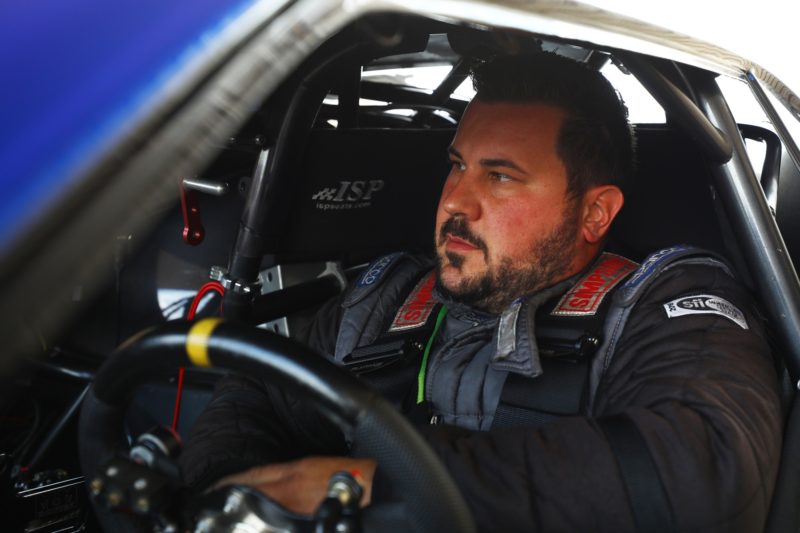
Carl Stevens Jr.
Both drivers have had success with the new combo. Hord qualified No. 8 at the World Doorslammer Nationals with a 5.709-second pass. Satterfield has been competing in Mid-West Pro Mod Series and PDRA Pro Boost competition during the NHRA shutdown. He and tuner Bob Gardner have found consistency and improved performance with the combination, even winning the MWPMS race at Xtreme Raceway Park in early July.
Stevens says his customers have been understandably thrilled with their newfound performance gains. Even “Turbo” Todd Moyer made the switch in his new Pro Boost/outlaw Pro Mod Camaro, which was an immediate player when it made its debut at the PDRA Carolina Showdown with Stevens tuning.
“I’ve really loved everything about the switch over to the ProCharger,” Stevens says. “I like tuning it. I think it’s a more raceable, easier to use combination.”
The 2018 Drag Illustrated World Series of Pro Mod champion admits he hasn’t had much time with the ProCharger combo on the tuning side, though he’s already assembled several F-3X-140-equipped engines and worked with them at a handful of events this season.
“As an engine builder, the engines are nearly identical,” Stevens says. “The only thing really different between the two power adders is basically the camshaft. Compression ratio and all that’s pretty similar between the two. Like I said, I think the ProCharger is a more raceable package. There’s less stuff to manage. There’s so many different things that can kind of sneak up and bite you on the turbo car that you really don’t have to deal with with the ProCharger.”
The Xtreme Racing Engines stable of ProCharger cars will soon expand to four, as Stevens has a new car coming together at Jerry Bickel Race Cars, and a ProCharger-boosted XRE Hemi will set between the frame rails.
“I’ve liked it so much – and I’ve been a turbo guy forever,” Stevens says. “I never would’ve even considered running another power adder. But after working with these three cars, I said I have to have one of these things myself.”
Making Big Power in Top Sportsman and Top Dragster
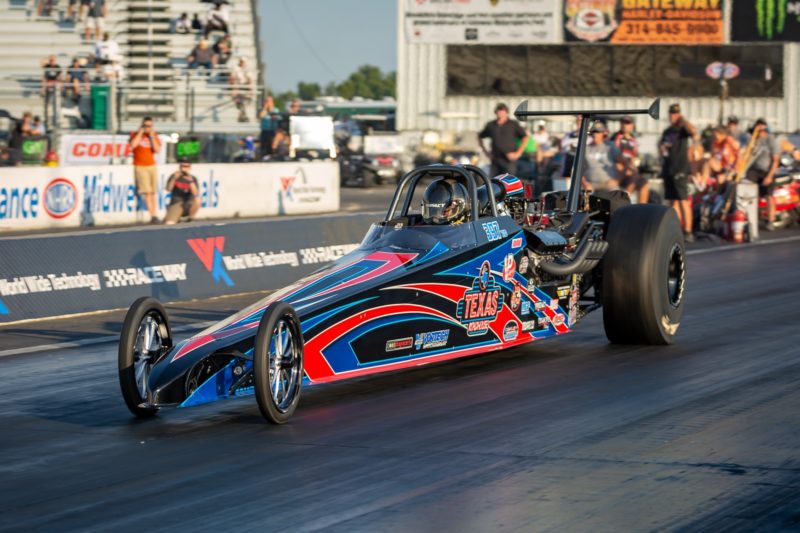
James Sisk photo
While ProCharger has been working on the Pro Modified market, Vortech has been closing in on the fast bracket racing world of Top Sportsman and Top Dragster. It’s an area of the sport where ProCharger customers have also performed very well. But Danny Nelson helped usher in a new era for Vortech in NHRA sportsman racing last season when he won the NHRA Top Dragster world championship with his Vortech V-30 123A-supercharged Danny Nelson Racecraft dragster.
“Words can hardly express how grateful we are to have racers like Danny Nelson supporting and believing in our centrifugal supercharger products,” says Lance Keck, who serves as Vortech’s race support director and engineering manager. “With Danny winning the championship last year, it really showed the entire drag racing world how Vortech Superchargers can help push their performance to the next level.”
Going into Nelson’s championship defense season, NHRA announced that Vortech was stepping up as the new title sponsor of the NHRA Top Sportsman and Top Dragster national championship series through 2022. It showed a serious interest and commitment to two classes filled with increasingly powerful cars and passionate, talented racers.
“We plan to continue with the support of the Top Dragster and Top Sportsman classes for many years to come,” says Jimmy Martz, Vortech’s sales and marketing director. “Being associated with the NHRA and their expansive reach opens up new opportunities and branding of Vortech Engineering’s products to all aftermarket automotive enthusiasts.”
Just like ProCharger and their partnership with Pro Line, Keck credits Vortech’s collaboration with engine builders and tuners as a driving force behind the company’s gains in Top Dragster and Top Sportsman. Vortech includes engine builders in the creation of new products like the new V-30 supercharger billet mounting bracket for big-block Chevy combinations, which is what a lot of the Top Dragster and Top Sportsman customers run.
“Relationships are the key to Vortech’s success, as engine builders and racers like Philip Oakley and many others are on the front lines at the track and definitely our eyes and ears in the sport,” Keck says. “Without this mutually beneficial relationship, we would have a difficult time engineering and developing new race-type products that directly supports their efforts.”

Phillip Oakley (right) with customer JB Strassweg
Oakley, who builds engines for drag racers and circle-track racers at Oakley Competition Engines, first started working with Vortech blowers two years ago when he realized he and his customers needed a competitive edge to keep up with an increasingly competitive class. He found what he was looking for – performance and reliability – in the Vortech combination.
“It seems the reliability is probably 25-30 percent better [compared to other power adders] as far as the number of runs you can put on the engine without service,” Oakley says. “I think if you’re starting a new program, especially if you’re not a nitrous tuner, it’s about the only way to fly, the centrifugal blower stuff. It has the durability, the ease of tuning, the big speed.”
The disadvantage to all that speed, as Oakley points out, is that you can’t use it all in Top Dragster and Top Sportsman. The minimum dial-in for NHRA Top Dragster and Top Sportsman is 6.10 seconds, and there are consequences beyond losing for going much quicker than that.
“All these engines that we’ve done have to be wheeled way back to be able to slow down that much,” Oakley says. “You take my car for example. It has to run 4.00s [in the eighth mile] to go 6.10 and it easily runs 3.70s. That’s the only disadvantage I’ve really seen. We’ve had to really slow the blowers down, and when you do that sometimes consistency goes away with it.”
Still, centrifugal superchargers have become one of the leading power adders in a class where consistency means a lot. Their use by world champions like Nelson and Marco Abruzzi have helped change the minds of nitrous guys, roots blower guys and even naturally aspirated believers.
“Let’s say three years ago, you kind of had to sell those packages,” Oakley says of the centrifugal blower combo for Top Dragster and Top Sportsman. “Now, there’s enough of them out there. We probably field a call every two weeks with somebody interested in one or asking information. We’re building two new ones in our shop right now in July, which is unheard of. We actually sold another one yesterday. A lot of people are taking notice.”
On top of the physical performance of the product, Oakley says Vortech’s customer service and development over the last few years have helped turn him and his customers into believers.
“I can call Lance [Keck] at 9 o’clock at night and he’s going to answer and do things to help us,” Oakley says. “That’s a big thing to me. Plus, personally, my business has had zero failures with Vortech stuff. That’s another big thing.”
What’s Next?

With more and more cars across numerous classes starting to run at the front with ProCharger and Vortech superchargers, more racers, tuners, engine builders and fans are beginning to understand the platform. Reaching all of those groups is important for both brands, as their performance on the track often leads to increased sales of their products built for the street.
“Our racing success trickles down to our street products and vice versa,” Sipp says. “For the future, it’s just reaching more customers who may not know about us or know about us and are unsure how to make that switch. We really work hard to make sure we can get in touch with those people on a real-world level, whether it’s through our site, them calling in, us going to the races or them talking to our customers.”
ProCharger will reach a whole new set of eyeballs when the NHRA Pro Mod Series makes its post-quarantine debut at the NHRA Summernationals at Indy, July 18-19.
The ProCharger combo led the pack in the cool spring air at the World Doorslammer Nationals in Orlando, but how will it fare in the muggy, Midwest summer heat?
“I think in certain conditions like you saw down there in Orlando when the air’s really good, it might actually be the quickest combination out there,” Stevens begins. “I can’t really say how much the air is going to affect it once we get into the hot summer air. The turbocharged stuff is the least affected by density altitude and things of that nature. The supercharged stuff, the ProCharger being one, is more susceptible to slowing down in those types of conditions.”
Stevens isn’t worried about a dramatic drop-off in performance out of the ProCharger setup during the summer months. It’s just too early to tell exactly what they’ll do, since the combination has only had limited quarter-mile Pro Mod experience with the current crop of Pro Line and Xtreme customers. But the uncertainty has Stevens looking forward to getting to Indy with Hord and Satterfield to continue his learning experience with the promising new combination.
“I think even if the rules stay as they are, it’s still going to be a competitive combination when the conditions get bad,” Stevens says. “We just don’t have enough runs with this crazy stuff we have going on to be at the same track in the same conditions with the other combinations to see how they stack up. I think they’ve done a pretty good job with the rules package so far. I think it’ll be right there with all the others.”


